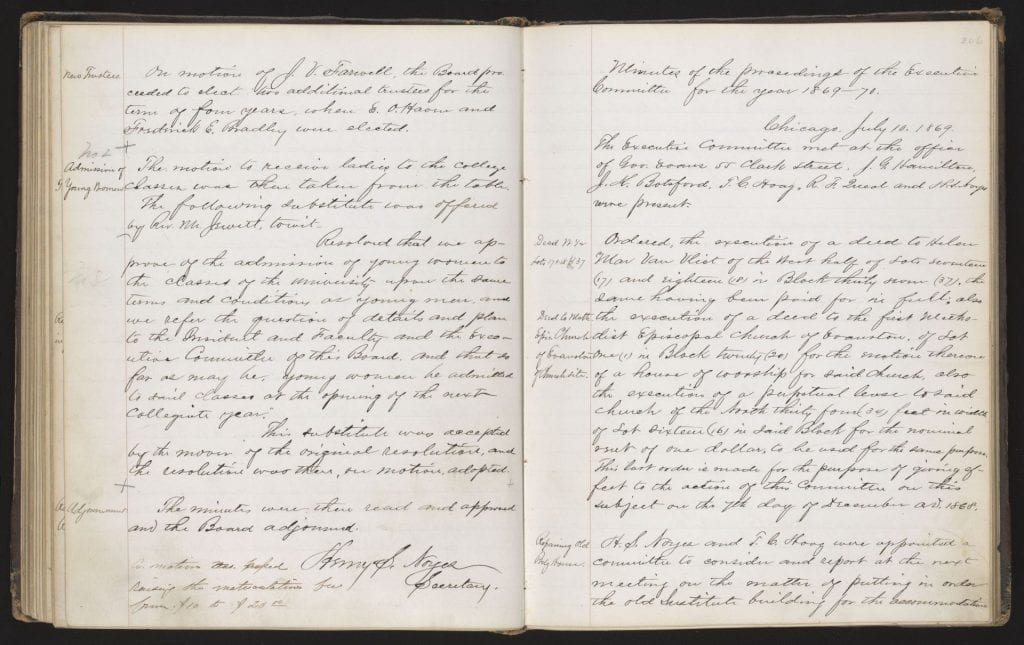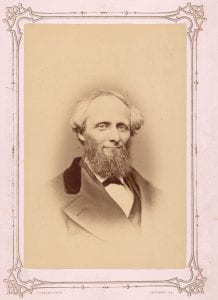In preparation for Commencement Day, a platform is set up in a shady grove on the campus grounds; sunlight shimmers on the lake in the background. Interim President David H. Wheeler distributes diplomas to the 14 proud young men of the graduating class amid benedictions, orations, and music. Later that day, however, the comfortable all-male atmosphere of Northwestern University will be dramatically disrupted, when the Board of Trustees passes a resolution to admit women students.
It’s June 23, 1869, and in this moment 150 years ago, our 14-year-old university changed its trajectory forever.
As Northwestern now prepares for the 2019 Commencement, we archivists mark the 150th anniversary of the establishment of coeducation here as an opportunity to explore a complicated and fascinating story that goes beyond Evanston to reflect issues about women’s history in the wider world.
The resolution passed by the board that day was the result of many forces, especially the arrival of the incoming president, Reverend Erastus O. Haven, who had been the president of the University of Michigan for the previous six years.
Haven was well respected for his teaching, educational administration, and service to the Methodist Episcopal Church. He was also a known advocate of coeducation, and the minutes for this meeting show that the resolution confirming his election was immediately followed by a unanimous resolution that Northwestern University would admit women on the same terms and conditions as men, starting with the opening of the next collegiate year.
But a thorough transcription of the entire Board of Trustees meeting, published in the Chicago Tribune on June 24, reveals a more contested process. Despite some members supporting a resolution to admit women on the same terms and conditions as men, the Board (composed of ministers, judges, faculty, and businessmen) only reached a unanimous agreement after considerable discussion. Those opposed to the concept expressed concern about the difficulty of providing the additional supervision women would need to keep them out of mischief, and about potential damage to the University’s reputation. Those in favor spoke about women’s rights and the advantages of offering coeducation to compete with a growing number of coeducational and degree-granting women’s colleges across the country. Despite the differences of opinion, the resolution finally passed unanimously.

Trustee Minutes for the June 23, 1869 meeting: “Resolved that we approve of the admission of young women to the classes of the University upon the same terms and conditions as young men, and we refer the question of details and plan to the President and Faculty and the Executive Committee of this Board and that so far as may be, young women be admitted to said classes at the opening of the next collegiate year.”
Though that single day in 1869 marks a turning point in history, coeducation at Northwestern did not occur quickly or easily. It was affected by such disparate factors as the Great Fire of Chicago, changes in administration, and societal transformations. This fall, we at the Libraries will be commemorating this anniversary with an exhibition, drawn from University Archives, about the co-education decision. Stay tuned to this blog from more vignettes of this history.
And many congratulations to the men and women of the class of 2019 who begin a new phase in their own journeys this weekend.
Janet Olson is an assistant University archivist at Northwestern Libraries
This fall marks 150 years since women could enroll as Northwestern undergraduate students. As the University collectively commemorates this milestone — and the women/womxn who have shaped Northwestern — the Northwestern community will have many opportunities to reflect, be inspired and learn from each other. Throughout the academic year, events and programming will be held across the entire University and around the world. Visit the 150 years of women website to learn more and get involved.

